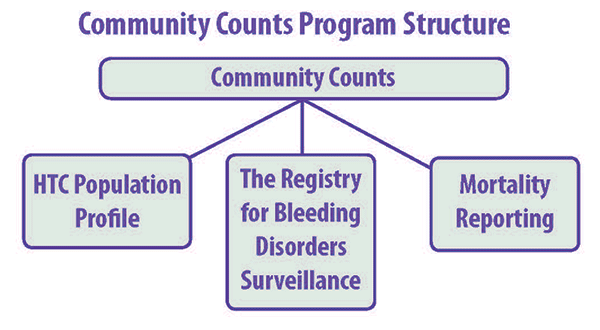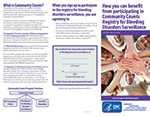About the Registry for Bleeding Disorders Surveillance
Brochure for Patients
Fact Sheet for HTC Clinicians and Staff

This fact sheet is for HTC clinicians and staff to provide additional information on the Community Counts Registry for Bleeding Disorder Surveillance.
About Community Counts
Community Counts is a public health monitoring program funded by CDC’s Division of Blood Disorders. The purpose of this project is to gather and share information about common health issues, medical complications, and causes of death that affect people with bleeding disorders cared for in the U.S. Hemophilia Treatment Centers (HTCs). Community Counts aims to continue the work of the Universal Data Collection System, which ended in 2011.
Community Counts is led by the Division of Blood Disorders along with its partners, the American Thrombosis and Hemostasis Network (ATHN) and the U.S. Hemophilia Treatment Center Network (USHTCN).
Read more about Community Counts »
The Registry for Bleeding Disorders Surveillance is a part of Community Counts

About The Registry for Bleeding Disorders Surveillance
The Registry for Bleeding Disorders Surveillance (“the Registry”) is a component of Community Counts, a public health monitoring program funded by CDC’s Division of Blood Disorders. Patients who volunteer to participate in the Registry will have routine medical information collected during visits to the HTC.
Specific goals of the Registry include the following:
- Measuring rates of complications of bleeding disorders (including those related to blood and treatment product safety).
- Monitoring trends over time in medical complications and treatment of bleeding disorders.
- Identifying people at high risk for complications of bleeding disorders in order to recommend them for prevention programs.
- Identifying issues that require further study.
Eligible HTC Patients are Invited to Participate
People can participate in the Registry if they have been diagnosed with a bleeding disorder and receive care at an HTC. Their condition must be present since birth and must be one of the following disorders:
- Hemophilia A (Classic Hemophilia/hereditary factor VIII (factor 8) deficiency).
- Hemophilia B (Christmas disease/hereditary factor IX (factor 9) deficiency).
- Von Willebrand Disease.
- Certain other rare bleeding disorders (disorders – other than deficiencies of factor VIII or IX – caused by a problem with a clotting factor in the blood).
- Genetic platelet function disorders (conditions in which the blood platelets—certain components of blood that help blood to clot normally—do not work the way they should).
- Inherited thrombocytopenia (a condition running in families where there aren’t enough platelets in the blood for normal blood clotting).
Approximately 70% of all people with hemophilia in the United States receive at least some of their care at one of the federally funded HTCs. The HTCs shown on the map below are currently participating in Community Counts, or are expected to begin participating in the near future.
- Page last reviewed: February 14, 2017
- Page last updated: February 14, 2017
- Content source:


 ShareCompartir
ShareCompartir
